Read almost any landscape design book and you’ll find the term “garden room.” That’s because designers look at the garden as an extension of the house — as a stage for living. And just like in a house, walls are one of the key elements defining an outdoor room.
From a design point of view, I define “wall” as any vertical structure, more or less, extending a few feet above the ground. You can build walls, grow them or split the difference by attaching a vine to a trellis. With so many available options and uses for walls, it's easy to get caught up with the "What will it look like?" excitement and lose sight of practical concerns.
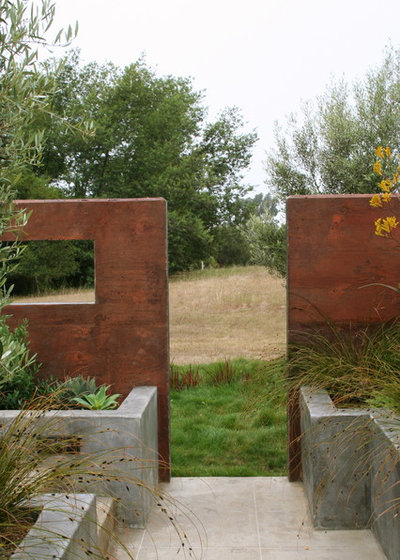
Kathleen Shaeffer Design, Exterior Spaces
Consider appearance. Most people would agree that putting a wooden split-rail fence around the White House would miss the mark. The casual, rustic style of a split-rail fence has nothing to do with the classic European, Palladian style of the White House's architecture. By the same token, you could cross adobe block off your list of materials around a Tudor cottage. There should be a logical conversation between the walls and the style of the house, the setting and the other garden features.
And as I'll discuss further on, walls that serve a strictly artistic purpose still need to fit with the rest of the garden, regardless of how eclectic your yard might be.
Consider practicality. On the other side of the coin, it's important to match the materials, size, location, durability and long-term sustainability of the walls, hedges or fences to their intended use. Security requires impregnability the way masonry or a tall iron fence can (we'll steer clear of barbed wire and gun turrets). Privacy means making smart decisions about height and density, so you can avoid prying eyes. Retaining walls require a certain level of mass and adequate footings to resist the forces of gravity.
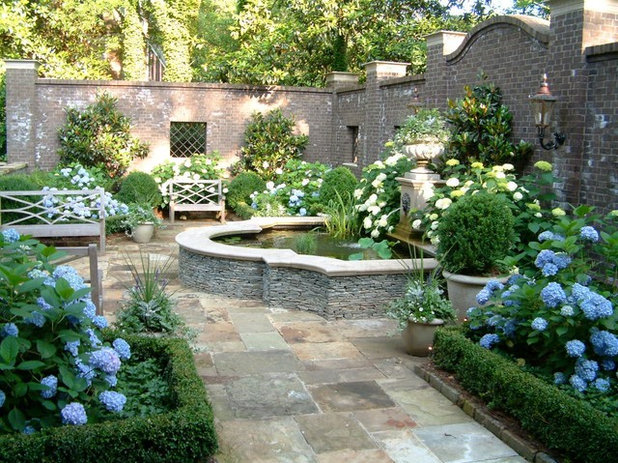
Howard Design Studio
Secure your borders. The most obvious place you’ll find a garden wall or fence is along the property lines. In tract house subdivisions, expedience and cost frequently result in not much more than a simple wood fence. This approach meets the developer’s needs but contributes very little, aesthetically speaking.
In contrast, this classic, beautifully crafted brick wall not only defines a peaceful courtyard, but also is tall and solidly built, assuring security. Another benefit of masonry walls is their rigidity and density, blocking and reflecting unwanted noise.
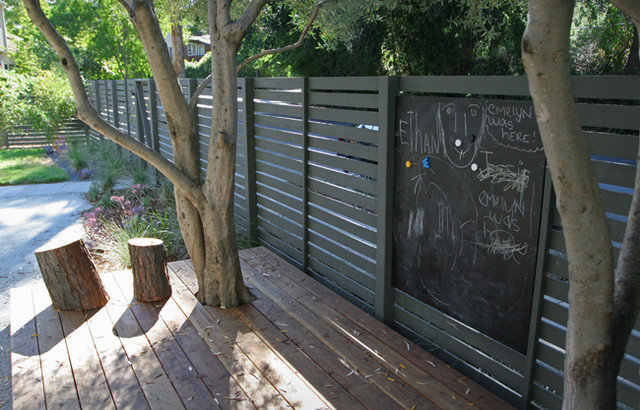
Not that there’s anything wrong with simple wood construction, especially for garden owners seeking a casual feel. Something as simple as setting the planks horizontally transforms the mundane into the unexpected, while still keeping an eye on the checkbook. Add a bit of fun and practicality with a chalkboard for the kids (or for grown-ups in touch with their inner doodler).
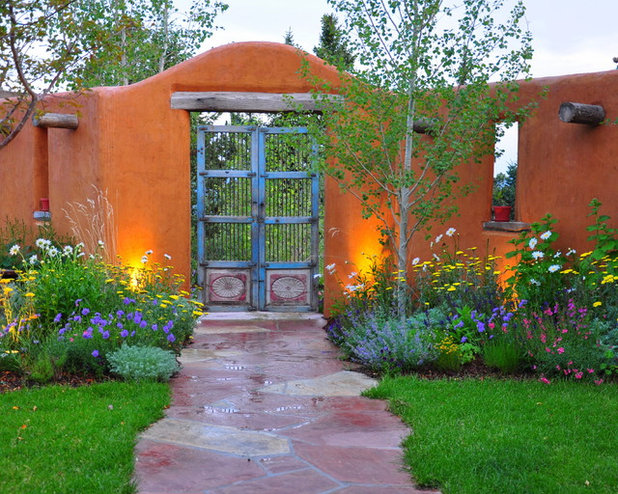
Designscapes Colorado Inc.
Since walls can be a dominant element in a garden and are present year-round, why not enlist their help in your color palette? Almost any surface can be painted or stained, but infusing stucco with integral color makes long-term maintenance a nonissue. This warm-hued Southwestern-style wall plays right into the floral color scheme of golden
Moonshine yarrow (
Achillea sp), while the gate echoes the cool tints of
catmint (
Nepeta sp) and
pincushion (
Scabiosa sp).
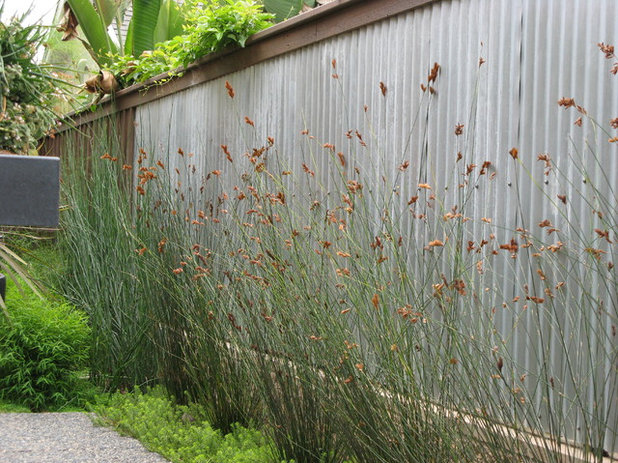
debora carl landscape design
Creating a contemporary feel comes easily when you substitute corrugated metal panels for wood. The rhythmically undulating surface complements delicately vertical plants, like
thrashing reed (
Thamnochortus insignis, zones 9 to 11), a South African native right at home in this simple, stylish corner of the yard.
Tip: Building and zoning codes may include restrictions about how high walls and fences can be within the setback areas of your property. Check with local officials before setting the height and location of your walls.
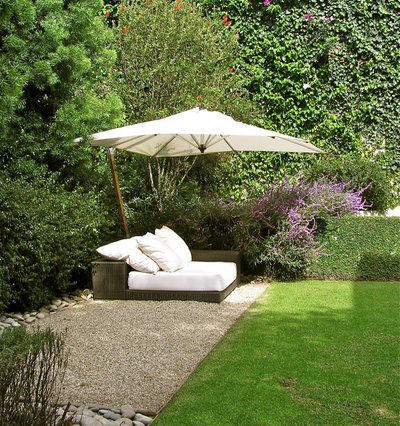
A Pleno Sol
Create privacy. If you’ve already got a serviceable, though less-than-lovely, wood (or, dare I say it, chain-link) fence and the cost of replacing it is too high, you can camouflage it with greenery. Living foliage has a vitality that’s impossible to achieve with constructed walls. Add the bonus of flowers, fragrance and the occasional hummingbird darting about, and it’s clear why so many designers choose the horticultural option.
That said, there are downsides to consider. Plants don’t live forever; sometimes they don’t even live for a few months. The long-term success of plants providing year-round security and privacy depends on your gardening abilities as well as the lack of pests or diseases that can wipe out a mature hedge in a season or two. Another point to ponder: Once a concrete block wall is completed, it’s unlikely you’ll spend your precious weekends shearing back new growth to keep it from swallowing up your patio. You can’t say that about a privet hedge.
More ideas for stylish backyard privacy
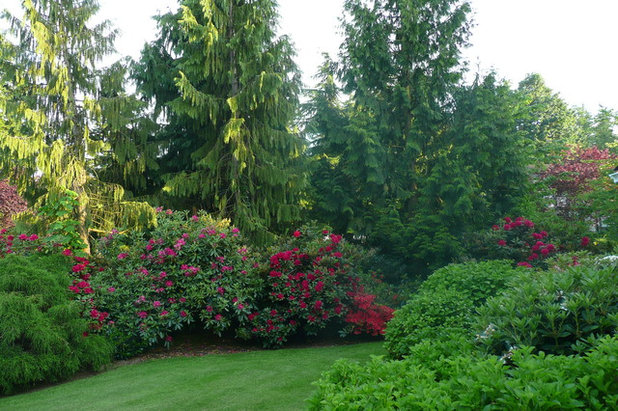 Cultivate calm.
Cultivate calm. A gentle breeze on a warm day is a welcome thing, but strong winds can turn reading the Sunday comics at the patio table into a Three Stooges comedy routine. It helps to understand the dynamics of airflow before you erect a windbreak, whether built or planted.
When wind hits a solid vertical surface, it compresses and spills over the wall, causing turbulence. This means that except for a short distance immediately against the lee side of a fence, your efforts might not be very effective. A better strategy, if space allows, is gradually lifting the wind by creating a build-up of elements. On the windward side of your garden, plant knee-high plants to start lifting the wind, backed by shoulder-high, then head-high plants and finally, a taller wall or fence, if needed. This will create a laminar flow and achieve a larger quiet zone for you to enjoy in your garden.
If there isn't adequate space, a diagonal board along the top of the fence, acting as an aerodynamic foil, can increase the windbreak's effectiveness. Another strategy is to filter, rather than block, the wind by planting shrubs or vines that allow some air to pass through them.
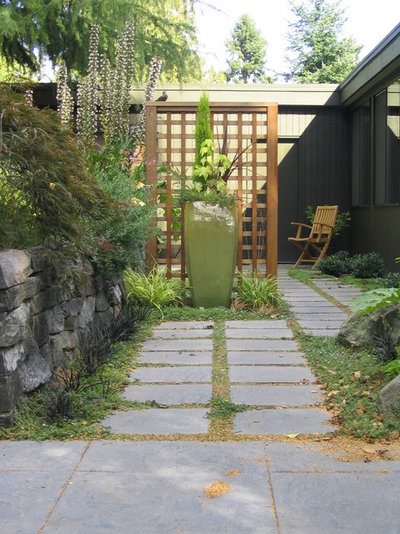
Banyon Tree Design Studio
Break up your space. Whether your garden is large or small, breaking it into smaller spaces — each with its own boundaries and personality — creates the illusion of more space. The solution can be as simple as erecting a partition that insinuates a separate space and serves as a gateway. In the garden here, an open grid of wood slats does double duty as a backdrop for a commanding focal point.
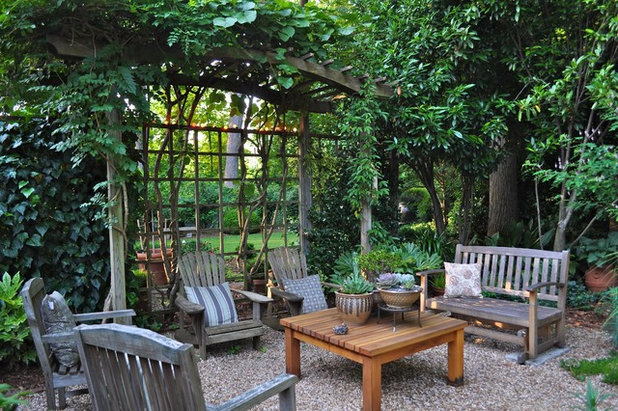
Bruce Clodfelter and Associates
Imagine this sitting area in the middle of an open lawn. “Cozy” is not an adjective that comes to mind. But enclose it within a simple vine trellis and a rich bed of greenery, and it takes on an intimate personality conducive to hours of conversation and relaxation.
Tip: If your goal is to create privacy for your dining patio or reading room — or any space where you’ll be seated — a 5-foot-tall hedge or wall is all it will take to make you disappear. Any taller and the space could feel claustrophobic. And keeping the top within easy reach makes trimming less of an ordeal.
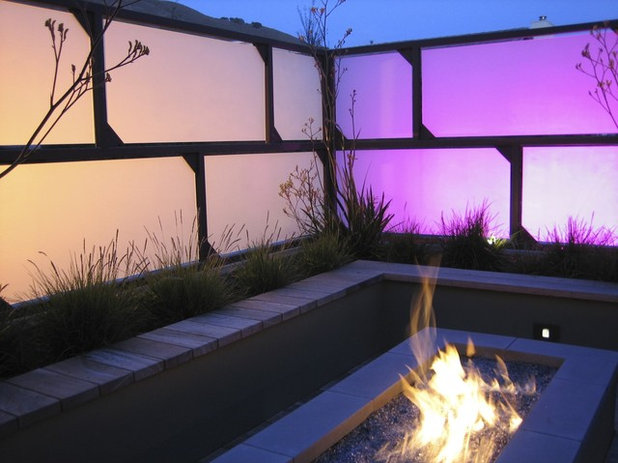
Jeffrey Gordon Smith Landscape Architecture
Looking for a bit of theatricality in your garden? By day this garden room has a crisp, architectural personality. But in the hands of Jeffrey Gordon Smith, who has a flair for innovative color use, nightfall transforms this patio into a magical environment. Sandblasted glass diffuses backlighting, recalling the magic of a dusky sunset.
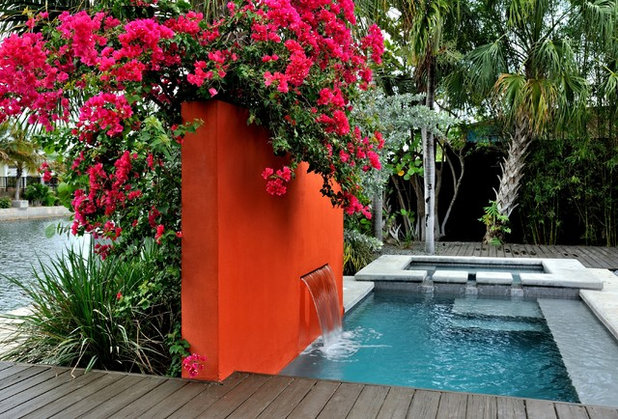 Amp up the wow factor.
Amp up the wow factor. There are times when the wall itself is the star player, embellished with bold colors, crafted of innovative materials or serving as a gallery for works of art.
The heat is on when a sensuous red bougainvillea spills over a fiery orange wall, creating the focal point in this contemporary tropical landscape. (Good thing there’s water nearby to cool things off.)
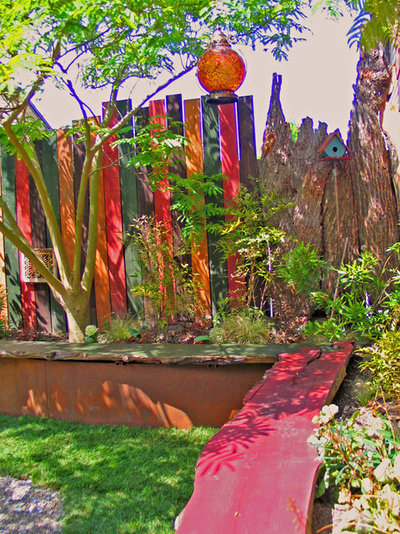
Exteriorscapes llc
As long as we’re thinking of walls as art, why not stop by the paint store and have some fun? This eclectic, giddy wood fence illustrates how recycled boards take on new life when you unleash your imagination and untether your paintbrush. See if there are existing materials in your garden you can put back into service with a sprinkling of imagination.
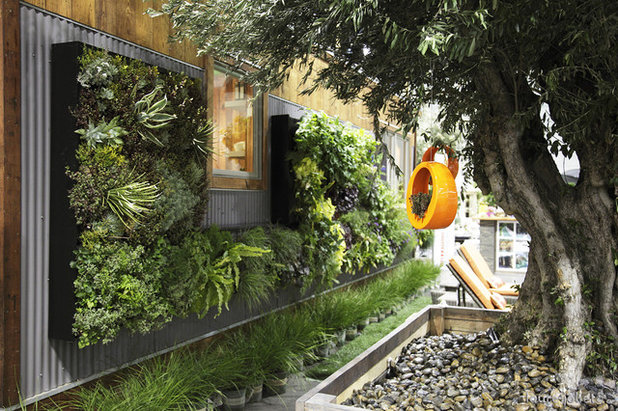
Shades Of Green Landscape Architecture
Turn your property’s edge into an art gallery by exploring the wonders of vertical gardening. There are dozens of companies offering do-it-yourself wall planters consisting of plastic honeycombs filled with potting mix, hydroponic systems with built-in watering devices or fabric pouches. Or custom design your own. Plant choices include succulents, exotic orchids and bromeliads, grasses, mosses and edible greens and herbs.
Tip: Garden Up! Smart Vertical Gardening for Small and Large Spaces, by Susan Morrison and Rebecca Sweet, is packed with great ideas for enhancing garden walls.
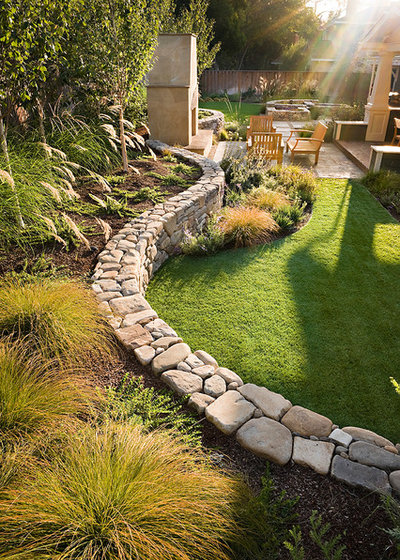
Sally Stoik Landscape Architect
Halt a hillside. Sloping properties come with the challenge of reclaiming enough usable flat space to make outdoor living practical. Since retaining walls tend to be highly visible, and often massive, take care to select materials that harmonize with the other built elements.
Natural fieldstone or river rock walls are a logical complement to a patio fashioned from irregular flagstone slabs. Taller retaining walls that require building permits and an engineer’s stamp are frequently built of concrete block, not the sexiest material to border your dining terrace, but their utilitarian appearance can be glammed up with a veneer of stone, brick or tile, or by coating it with colored or textured stucco or plaster.
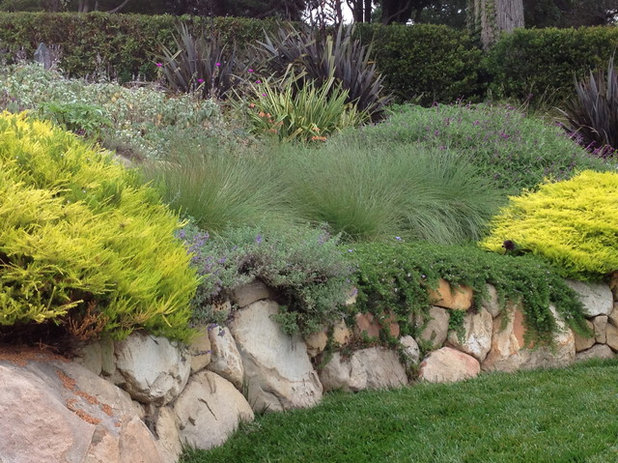
Pat Brodie Landscape Design
Retaining wall areas are great places in which to strut your planting prowess. Plants that might otherwise go unnoticed at ankle level are elevated where they can be viewed, caressed and sniffed. Have your wall play hide and seek by growing spillers like rosemary, campanula, carpet roses or stonecrop at the front of a bed.
However, slopes can be tough places for plants to grow on; they frequently lack an adequate depth of topsoil for deep root growth. Amend your soil after seeking advice from local garden experts. Provide good drainage behind the wall with porous gravel wrapped in filter fabric, and with weep holes to allow excess water to drain out of the root zone. And research native plants that have adapted to similar growing conditions in their evolution.
Next: How to Pick the Right Floor for Your Garden Room





